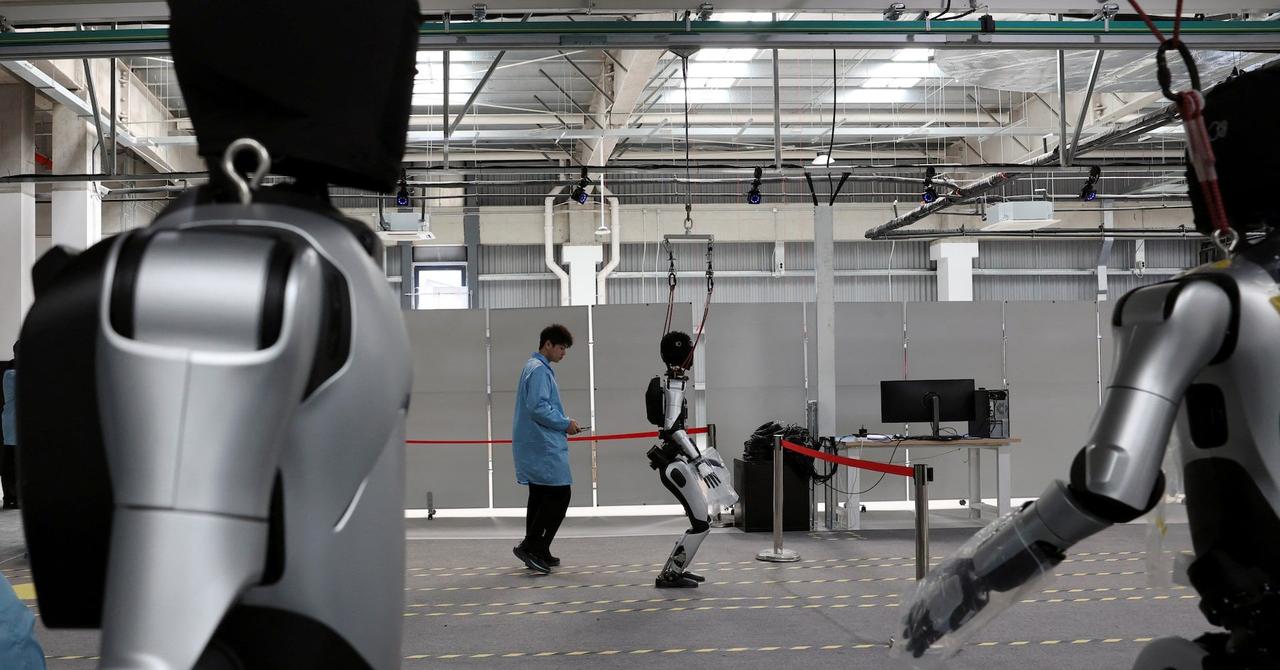China Unveils First Humanoid Robot Training Base in Shanghai, Aiming to Train 1,000 Robots by 2027
2 Sources
2 Sources
[1]
Video. China unveils first humanoid robot training base in Shanghai
On Tuesday, China has launched its first heterogeneous humanoid robot training centre in Shanghai's Pudong District. The Humanoid Robot Kylin Training Ground aims to advance cross-disciplinary robotics, including AI and machine learning, and can currently train over 100 robots, with plans to scale up to 1,000 by 2027. On Tuesday, China has launched its first heterogeneous humanoid robot training centre in Shanghai's Pudong District. The Humanoid Robot Kylin Training Ground aims to advance cross-disciplinary robotics, including AI and machine learning, and can currently train over 100 robots, with plans to scale up to 1,000 by 2027. The centre will collaborate with local robotics firms to amass a vast dataset of 10 million high-quality physical data entries by 2025. These efforts aim to enhance the practical application of humanoid robots in sectors such as manufacturing and public services. Amid an ageing population and global tech competition, humanoid robots are seen as a solution to workforce challenges and a driver of industrial innovation. By 2030, China's humanoid robot market is expected to soar to €11.35 billion. The Pudong facility also plans to unveil its next-generation robot, "Deep Snake," featuring advanced technologies for enhanced flexibility and intelligence. Beijing is set to host the inaugural World Humanoid Robot Sports Games later this year.
[2]
China's first humanoid base plans to train 1,000 robots by 2027
China has launched its first heterogeneous humanoid robot training base, which is situated in Shanghai. Named the Humanoid Robot Kylin Training Ground, and is operated by Shanghai-based National and Local Co-Built Humanoid Robotics Innovation Center, Humanoid Robot (Shanghai) Co. With the ability to train more than 100 humanoid robots at once, the cutting-edge facility hopes to hasten the widespread use and commercialization of cutting-edge robotics technology. According to a Chinese online media outlet, the facility plans to train 1,000 general-purpose robots at once by 2027. In December, Chinese robotics company AgiBot introduced the largest humanoid manipulation dataset to date, aiming to enhance AI robot training. The humanoid robot training ground is designed to play a key role in advancing the development of the industry and supporting the implementation of diverse application scenarios. According to Global Times (GT), by providing tailored training environments for sectors such as intelligent manufacturing and public services, the facility aims to drive technological innovation and facilitate industrial upgrades through collaboration among enterprises. To better train general-purpose humanoid robots, the center will collaborate with Shanghai-based manufacturers, including Zhiyuan Robotics and Kupas Technology Co. By the end of 2025, the initiative aims to collect 10 million high-quality physical data entries, creating one of the industry's most advanced heterogeneous embodied datasets. The effort aligns with China's broader strategy to strengthen its position in artificial intelligence and robotics, addressing both global tech competition and the challenges of an aging society. Advanced embodied intelligence and autonomous driving technologies are becoming more and more common in humanoid robots, allowing for more intelligent and flexible operations to help achieve these objectives. Next, the center intends to introduce the 2.0 iteration of their humanoid robot, called "Deep Snake." GT reports that this new model will showcase key advancements such as linear joint actuators, which are meant to enhance the versatility and performance of humanoid robots and solidify China's leadership in the robotics industry.
Share
Share
Copy Link
China launches its first heterogeneous humanoid robot training center in Shanghai, capable of training over 100 robots simultaneously. The facility aims to advance robotics technology and plans to scale up to 1,000 robots by 2027.

China's Ambitious Humanoid Robot Training Initiative
In a significant move to advance its position in artificial intelligence and robotics, China has unveiled its first heterogeneous humanoid robot training base in Shanghai's Pudong District. The Humanoid Robot Kylin Training Ground, operated by the National and Local Co-Built Humanoid Robotics Innovation Center and Humanoid Robot (Shanghai) Co., marks a major step forward in the country's robotics ambitions
1
.Cutting-Edge Facility and Training Capabilities
The state-of-the-art facility is currently capable of training over 100 humanoid robots simultaneously, with ambitious plans to scale up to 1,000 robots by 2027
2
. This expansion aims to accelerate the development and commercialization of advanced robotics technology, addressing both global tech competition and the challenges posed by China's aging population.Collaborative Efforts and Data Collection
To enhance the training of general-purpose humanoid robots, the center is collaborating with Shanghai-based manufacturers, including Zhiyuan Robotics and Kupas Technology Co. The initiative aims to collect 10 million high-quality physical data entries by the end of 2025, creating one of the industry's most advanced heterogeneous embodied datasets
2
.Applications and Market Projections
The training ground is designed to support the implementation of diverse application scenarios, particularly in sectors such as intelligent manufacturing and public services. These efforts are expected to drive technological innovation and facilitate industrial upgrades. With the humanoid robot market in China projected to reach €11.35 billion by 2030, the initiative aligns with the country's broader strategy to strengthen its position in AI and robotics
1
.Related Stories
Future Developments
The center has announced plans to introduce the next generation of their humanoid robot, dubbed "Deep Snake." This 2.0 iteration will feature advanced technologies such as linear joint actuators, aimed at enhancing the flexibility and intelligence of humanoid robots
2
. Additionally, Beijing is set to host the inaugural World Humanoid Robot Sports Games later this year, further showcasing China's commitment to advancing robotics technology1
.Global Context and Implications
China's investment in humanoid robotics comes amid increasing global competition in AI and robotics. The establishment of this training base not only addresses domestic challenges such as an aging workforce but also positions China as a leader in the rapidly evolving field of robotics. As countries worldwide race to develop advanced AI and robotic technologies, China's initiative may have significant implications for the global tech landscape and industrial innovation.
References
Summarized by
Navi
[2]
Related Stories
Beijing Hosts Inaugural World Humanoid Robot Games: A Showcase of AI and Robotics Progress
15 Aug 2025•Technology

China's AI Ambitions on Display: Beijing Opens Pioneering Robot Store
07 Aug 2025•Technology

China's AI-Powered Humanoid Robots: Transforming Manufacturing and Driving Economic Growth
13 May 2025•Technology

Recent Highlights
1
Google launches Gemini 3 Flash as default AI model, delivering speed with Pro-grade reasoning
Technology

2
OpenAI launches GPT Image 1.5 as AI image generator war with Google intensifies
Technology

3
OpenAI launches ChatGPT app store, opening doors for third-party developers to build AI-powered apps
Technology





